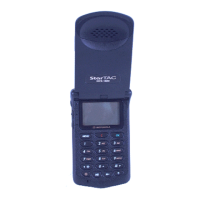Customer Services Publishing
Easter Inch, Bathgate, West Lothian
EH48 2EH, United Kingdom
BDesc2
© Motorola Ltd. 1997
All Rights Reserved
Printed in U.K.
DCS 1800 StarTAC PERSONAL
CELLULAR TELEPHONE
DESCRIPTION
GENERAL
68P09304A85
19/07/97
1
Cellular Subscriber Group
SYSTEM DESCRIPTION
1. D.C.S. SYSTEM OVERVIEW
1.1 GENERAL CELLULAR CONCEPT
The cellular systems are used to provide radiotelephone
service in the frequency range 1710-1880MHz. A cellular
system provides higher call handling capacity and system
availability than would be possible with conventional
radiotelephone systems (those which require total system
area coverage on every operating channel) by dividing the
system coverage area into several adjoining sub-areas or
cells.
Each cell contains a base station (cell site) which provides
transmitting and receiving facilities, for an allocated set of
duplex frequency pairs (channels). Since each cell is a
relatively small area, both the cell site and the radiotelephone
that it supports can operate at lower power levels than would
be used in conventional systems. Using this technique,
radiation on a given channel is virtually contained in the cell
operating on that channel and, to some extent, those cells
directly adjacent to that cell.
Since the coverage area of a cell on a given channel is limited
to a small area (relative to the total system coverage area), a
channel may be reused in another cell outside the coverage
area of the first. By this means, several subscribers may
operate within the same geographic area, without
interference with each other, on a single channel.
The following description is intended only as a
preliminary general introduction to the Digital
Communications System (D.C.S) cellular
network. This description is greatly simplified and
does not illustrate the full operating capabilities,
techniques, or technology incorporated in the
NOTE
1.2 G.S.M. DESCRIPTION
Unlike previous cellular systems, D.C.S. uses digital radio
techniques. The D.C.S.system has the following advantages
over previous analogue systems:-
• International Roaming - Due to international
harmonization and standardization, it will be possible
to make and receive calls in any country which
supports a D.C.S. system.
• Digital Air Interface - The D.C.S. phone will provide
an entirely digital link between the telephone and the
base station, which is, in turn, digitally linked into the
switching subsystems and on into the PSTN.
• ISDN Compatibility - ISDN is a digital
communications standard that many countries are
committed to implementing. It is designed to carry
digital voice and data over existing copper telephone
cables. The D.C.S. phone will be able to offer similar
features to the ISDN telephone.
• Security and Confidentiality - Telephone calls on
analogue systems can very easily be overheard by the
use of a suitable radio receiver. D.C.S. offers vastly
improved confidentiality because of the way in which
data is digitally encrypted and transmitted.
• Better Call Quality - Co-channel interference,
handover breaks, and fading will be dealt with more
effectively in the digital system. The call quality is
also enhanced by error correction, which reconstructs
lost information.
• Efficiency - The D.C.S. system will be able to use
spectral resources in a much more efficient way than
previous analogue systems.

